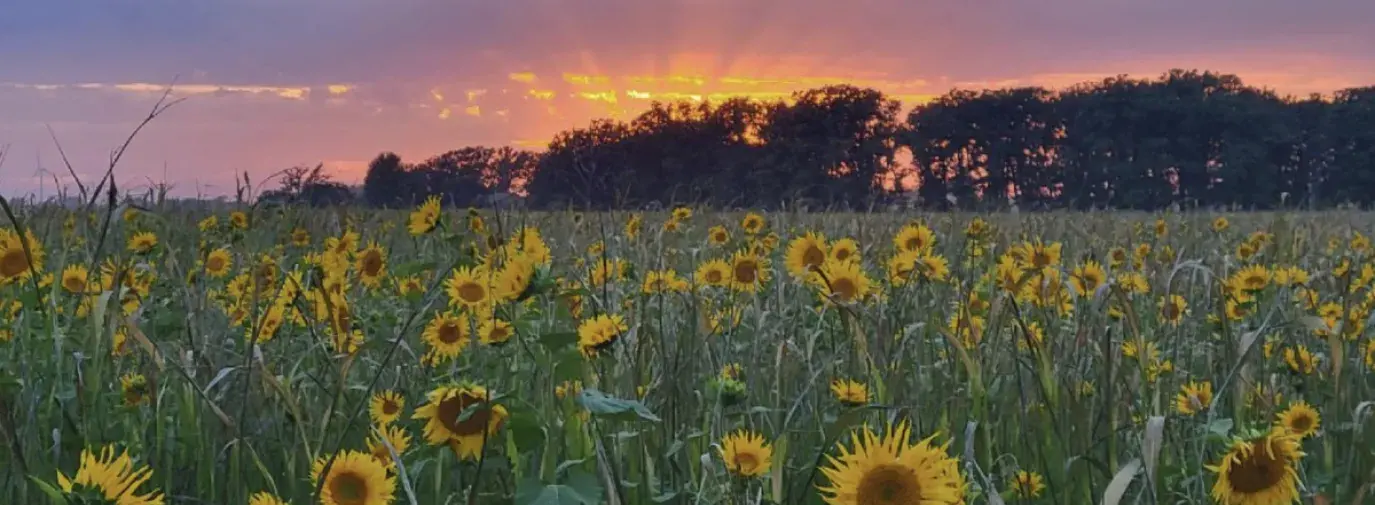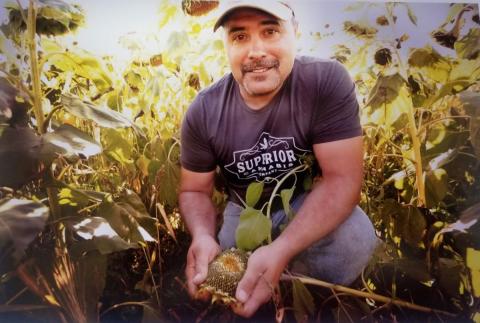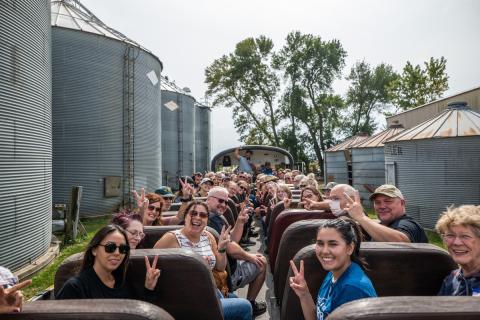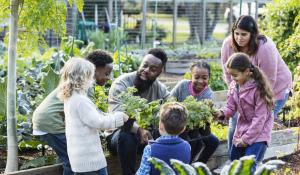
It was neck-deep in the dirt, digging lines and building drainage, where Tom Cotter’s journey as a regenerative farmer began.
“I would spend weeks in trenches, four, five feet down, running tile lines [irrigation] and the soil always smelled dead, smelled stale,” says Cotter. “And then when we started doing cover crops, I realized, wow, it smells good. Like a good cup of coffee.”
Cotter is a fourth-generation farmer in Austin, Minnesota, and is part of Green America’s Soil Carbon Alliance, which is a network of farmers, distributors, and companies seeking to transform the agricultural system from industrial and conventional to healthy and regenerative.
Now his days in the trenches are decades ago, and he has nearly 25 years of experience in cover-cropping. With that, Cotter has learned how to transition his farm that used to be fully tilled and use synthetic chemicals and fertilizers—to regenerative, filled with life above and below the soil. Cotter’s fields are brimming with biodiversity, from red clover to cattle and earthworms to ladybugs. This multi-species approach speeds up the transition to regenerative and marks him as a leader in the regenerative agricultural space.
Cover Crops for a Change
Cotter and his father would till all the acres—which means stirring up the entire topsoil—until 1998 when they bought a tile pile, the equipment for installing large, plastic drainage pipes in fields to distribute water evenly. While installing the tiling pipes, Cotter realized his soil was just dirt.
Cotter started using cover crops at the same time as the tile pile, and the differences between the tiled and covered fields and the full tillage fields were noticeable immediately—not just in smell, but in the new population of earthworms. Cover crops are exactly what they sound like, crops that grow to provide living cover above and below ground to protect the top layer of soil.
Seeing earthworms meant they were doing something right. But in the 90s, cover cropping was nearly unheard of among conventional tillage farmers. Cotter spoke to several agronomists who all said what he was doing wouldn’t work. Transitioning to regenerative fields typically hurts farmers financially during the first few years, until the microorganisms, nutrients, and organic matter have time to restore the soil and grow healthy crops worth selling.

Despite the naysayers, he continued to transition fields. When Cotter introduced livestock grazing in 2015, things really started changing. Before, he’d find fifty earthworms if he dug a hole. After adding livestock, he’d find hundreds. He’s since added alfalfa, red clover, white clover, and other grasses to fields in transition—these act as cover crops and as forageable feed for his livestock. He uses livestock to get the soil healthier faster to make it easier to transition to organic.
“The more species you have, the more microbe colonies you’ll get to work with and the more nutrients available,” says Cotter.
Now, a third of Cotter’s 800 acres are USDA-certified organic, where he grows corn, sunflowers, soybeans, oats, and hemp, all regeneratively managed.
On Land and In Business
For most farmers, the idea of losing profit in the transition to organic and regenerative can cause hesitation. But just as Cotter uses diversity to expedite fields in transition, he diversifies his income to protect the financial health of the farm.
Cotter’s cattle serve two purposes: to transition fields and to sell for beef. His cows eat nothing but forage and grass in pastures their entire lives, helping to stir up the topsoil with their hooves and adding nutrients and microbes to the soil in their manure. Cattle are born and raised on the farm until it’s time to sell as “grass-finished” beef.
Additionally, Cotter has a family-owned and -operated CBD business. Cotter grows regenerative and USDA-certified organic hemp on the farm just a few miles from his shop in Austin, Superior Cannabis Company. His two sons and one daughter operate Austin and Duluth, Minnesota, locations as managers and wholesalers.
“We have to separate ourselves from the thousand other hemp growers, so that’s why it’s certified organic and certified water quality [with the Minnesota Department of Agriculture],” says Cotter. “I’m proud of it. Most companies just say, ‘raised organically.’”

Doing What’s Best
Doing things differently is how Cotter became a leader in the regenerative and organic agriculture spaces, modeling the way for other conventional farmers to make a change. It’s part of his upbringing. As an adoptee, he was often confused about who he was and felt like he didn’t fit in.
“Growing up when you don’t know what you are, the most important thing is I’m myself. I strictly do the best that I can do as myself,” Cotter says.
Doing his best by himself, by his family, and by his farm and cattle is what Cotter excels at. He plans everything ahead of time to ensure the best possible outcome for the crops and livestock.
“I treat every field individually,” he says. “You don’t treat all your kids the exact same way because they’re all different. It’s the same with my fields.”
“When I first started [with regenerative agriculture] I would write down what plants [the livestock] ate first and think, okay, that’s the most important one. And then a week later, we’d move them to a different spot, and they’d eat something totally different,” Cotter adds. “I had to quit thinking I know it all and just observe and see what’s really happening. Too many times, farmers, people, we think we know it all. And we really don’t. That’s one of the best lessons for me.”
Cotter hopes to instill in other farmers the importance of diversity on a farm, both in animals and plants. And from that diversity, understanding that the complexities and the nuances of it all is something to learn from; no matter what, living harmoniously with the land is a never-ending growing experience.







